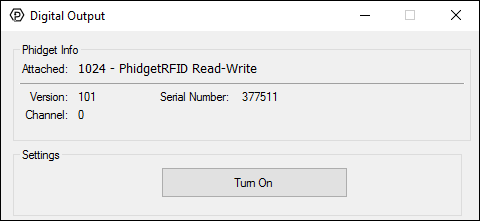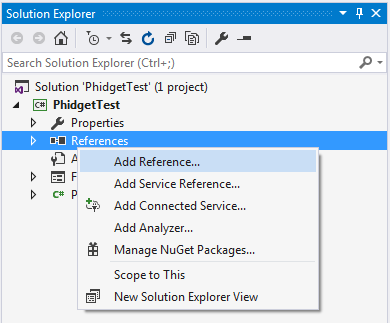Language - C Sharp Windows Visual Studio
| C# Development Environments | ||||
|---|---|---|---|---|
|
Language - C# Windows with Visual Studio Welcome to using Phidgets with C#! By using C#, you will have access to the complete Phidget22 API, including events. Visual Studio is an IDE provided by Microsoft that can be used to develop code in a wide variety of programming languages, including C#. |
Install Phidget Drivers for Windows
Before getting started with the guides below, ensure you have the following components installed on your machine:
- You will need the Phidgets Windows Drivers
Use Our Examples
One of the best ways to start programming with Phidgets is to use our example code as a guide. In order to run the examples, you will need to download and install Microsoft Visual Studio.
Now that you have Microsoft Visual Studio installed, select an example that will work with your Phidget:
Open the example project and start the example by pressing the Start button:

The application will open the Phidget, list basic information about the Phidget, and demonstrate the Phidget's functionality. Here is an example of a Digital Output channel on a RFID Phidget:

You should now have the example up and running for your device. Play around with the device and experiment with some of the functionality. When you are ready, the next step is configuring your project and writing your own code!
VINT Hub
If you are trying to connect to one of the VINT hub ports directly rather than to a VINT device connected through a VINT hub then there is one additional step. There is a isHubPort property of the Phidget class that must be set before calling open. It defaults to false but in this case it will need to be set to true. In our examples this is done via command line though in practice you can just set it before calling open. To add command line parameters to your project in Visual Studio, you can go to the Project->Properties screen. Under the Debug section there is a field to enter command line parameters for startup. Use "-h" to make sure isHubPort is set before open is called and then you should be good to go.

Configure Your Project
When you are building a project from scratch, or adding Phidget functionality to an existing project, you'll need to configure your development environment to properly link the Phidget .NET library. To begin:
Create a new Windows Forms Application project:

Next, right-click to add a reference to the Phidget .NET library:

On the following screen, click Browse... and navigate to the location of Phidget22.NET.dll:
- C:\Program Files\Phidgets\Phidget22\Phidget22.NET.dll

Finally, to include the Phidget .NET library, add the following lines to main window class file:
using Phidget22;
using Phidget22.Events;
Success! The project now has access to Phidgets. Next, view the write your own code section located below.
Write Code
By following the instructions for your operating system and compiler above, you now have working examples and a project that is configured. This teaching section will help you understand how the examples were written so you can start writing your own code.
Remember: your main reference for writing C# code will be the Phidget22 API Manual and the example code.
Step One: Step One: Create and Address
You will need to declare your Phidget object in your code. For example, we can declare a digital input object like this:
DigitalInput ch = new DigitalInput();
Next, we can address which Phidget we want to connect to by setting parameters such as DeviceSerialNumber.
ch.DeviceSerialNumber = 496911;
Although we are not including it on this page, you should include error handling for all Phidget functions. Here is an example of the previous code with error handling:
try{
ch = new DigitalInput();
ch.DeviceSerialNumber = 496911;
}catch(PhidgetException ex){
Console.WriteLine("Error: " + ex.Description);
}
Step Two: Open and Wait for Attachment
After we have specified which Phidget to connect to, we can open the Phidget object like this:
ch.Open(5000);
To use a Phidget, it must be plugged in (attached). We can handle this by calling Open(timeout), which will block indefinitely until a connection is made, or until the timeout value is exceeded. Simply calling Open does not guarantee you can use the Phidget immediately.
Alternately, you could verify the device is attached by using event driven programming and tracking the attach events.
To use events, we have to modify our code slightly:
ch = new DigitalInput();
ch.Attach += onAttachHandler;
ch.Open(5000);
Next, we have to declare the function that will be called when an attach event is fired - in this case the function onAttachHandler will be called.
void onAttachHandler (object sender, Phidget22.Events.AttachEventArgs e){
attachedText.Text = "Attached";
}
We recommend using this attach handler to set any initialization parameters for the channel such as DataInterval and ChangeTrigger from within the AttachHandler, so the parameters are set as soon as the device becomes available.
Step Three: Do Things with the Phidget
We recommend the use of event driven programming when working with Phidgets. In a similar way to handling an attach event as described above, we can also add an event handler for a state change event:
ch = new DigitalInput();
ch.Attach += onAttachHandler;
ch.StateChange += onStateChangeHandler;
ch.Open();
This code will connect a function and an event. In this case, the onStateChangeHandler function will be called when there has been a change to the devices input. Next, we need to create the onStateChangeHandler function:
void onStateChangeHandler(object sender, Phidget22.Events.DigitalInputStateChangeEventArgs e) {
stateText.Text = "State: " + e.State;
}
If you are using multiple Phidgets in your program, check out our page on Using Multiple Phidgets for information on how to properly address them and use them in events.
If events do not suit your needs, you can also poll the device directly for data using code like this:
stateText.Text = "State: " + ch.State;
Important Note: There will be a period of time between the attachment of a Phidget sensor and the availability of the first data from the device. Any attempts to get this data before it is ready will result in an exception. See more information on this on our page for Unknown Values.
Enumerations
Some Phidget devices have functions that deal with specific predefined values called enumerations. Enumerations commonly provide readable names to a set of numbered options.
Enumerations with Phidgets in Visual Basic .NET will take the form of Phidget22.EnumerationType.Enumeration_Name.
For example, specifying a SensorType to use the 1142 for a voltage input would look like:
Phidget22.VoltageSensorType.PN_1142
and specifying a K-Type thermocouple for a temperature sensor would be:
Phidget22.ThermocoupleType.K
The Phidget error code for timing out could be specified as:
Phidget22.ErrorCode.Timeout
Step Four: Close and Delete
At the end of your program, be sure to close your device.
ch.Close()
Further Reading
Phidget Programming Basics - Here you can find the basic concepts to help you get started with making your own programs that use Phidgets.
Data Interval/Change Trigger - Learn about these two properties that control how much data comes in from your sensors.
Using Multiple Phidgets - It can be difficult to figure out how to use more than one Phidget in your program. This page will guide you through the steps.
Polling vs. Events - Your program can gather data in either a polling-driven or event-driven manner. Learn the difference to determine which is best for your application.
Logging, Exceptions, and Errors - Learn about all the tools you can use to debug your program.
Phidget Network Server - Phidgets can be controlled and communicated with over your network- either wirelessly or over ethernet.
